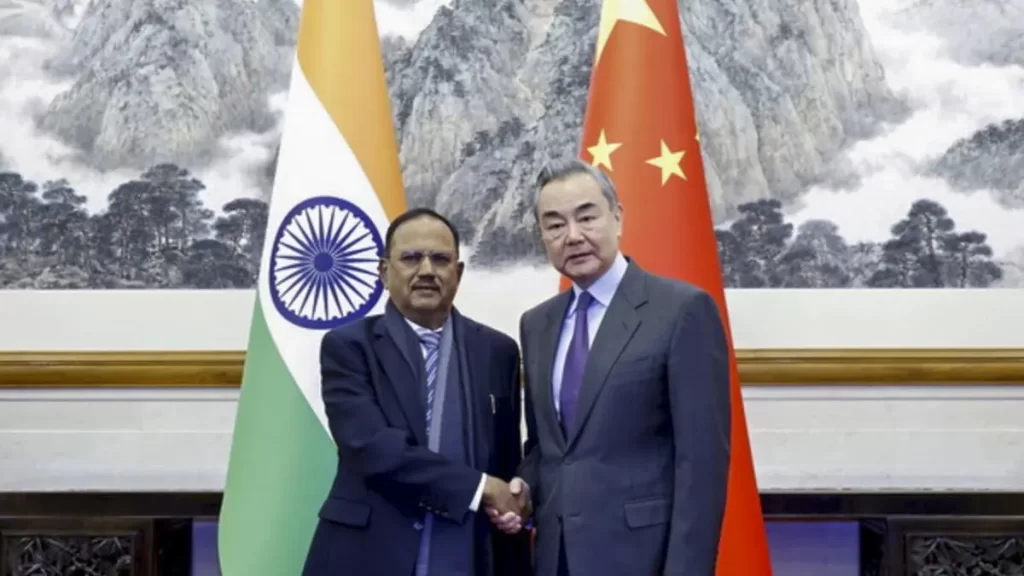In a significant diplomatic breakthrough, India and China have jointly acknowledged the positive outcomes of their disengagement efforts at the Line of Actual Control (LAC). This development comes as National Security Advisor Ajit Doval and Chinese Foreign Minister Wang Yi convened for their first boundary talks in Beijing on December 18, 2024. This marked the resumption of the Special Representatives (SR) dialogue after a five-year hiatus, underscoring a renewed commitment to bilateral engagement and peace-building.
India and China Affirmation of Disengagement Efforts
During the dialogue, both leaders reflected on the importance of learning from the prolonged military standoff at the LAC, which had strained relations since 2020. By emphasizing peace and stability, they provided clear directions for advancing cross-border exchanges. Key areas of focus included the revival of the Kailash Mansarovar pilgrimage, enhancement of border trade, and improved data-sharing mechanisms on trans-border rivers.
The Chinese Ministry of Foreign Affairs highlighted that the discussions led to a “six-point consensus,” which emphasizes maintaining peace along the borders while fostering bilateral ties. Although India’s Ministry of External Affairs (MEA) did not explicitly reference this consensus, it reiterated shared priorities, including ensuring peace at the LAC and pursuing a comprehensive boundary resolution.
Historical Context and Diplomatic Rebuilding
This renewed engagement represents a significant step in mending relations between the two nations. The SR dialogue, which began in 2003, aims to find a lasting resolution to the boundary disputes. The last formal meeting in this series occurred in 2019, prior to heightened tensions at the border. Subsequent incidents, such as the Galwan Valley clashes, underscored the urgent need for de-escalation and trust-building measures.
The October 2024 agreement on disengagement at key friction points like Depsang and Demchok in eastern Ladakh laid the groundwork for these talks. The successful verification of disengagement processes has allowed both sides to resume a focus on de-escalation and troop reduction.
Moving Beyond Border Frictions
In addition to border management, the discussions signaled a broader commitment to repairing other aspects of bilateral relations. Both sides acknowledged the necessity of restoring pre-2020 exchanges in areas such as trade, culture, and economic cooperation. While topics like resuming direct flights and journalist exchanges were not explicitly mentioned in the SR meeting, they remain part of the larger dialogue, as evidenced by recent talks between External Affairs Minister S. Jaishankar and Wang Yi in Rio de Janeiro.
High-Level Engagements
Beyond the SR dialogue, Mr. Doval also met with Chinese Vice President Han Zheng in Beijing. Their discussions reinforced the strategic importance of India-China relations as global powers with ancient civilizations. Vice President Han emphasized the need for restoring political trust and fostering collaborations in economic, trade, and cultural spheres to ensure steady development in bilateral ties.
Mr. Doval reciprocated by highlighting the significance of resuming the SR process after five years. He reiterated India’s commitment to strengthening strategic communication with China and injecting fresh momentum into the relationship. Notably, Mr. Doval extended an invitation to Mr. Wang for the next round of talks in New Delhi.
Peace and Stability as Cornerstones
The reaffirmation of peace and tranquillity at the LAC is seen as a pivotal step in ensuring that border disputes do not hinder the overall development of bilateral relations. Both sides acknowledged the lessons learned from the events of 2020 and discussed measures to enhance border management. These include maintaining the disengagement agreements and ensuring that patrolling and grazing rights are respected.
The talks also highlighted the importance of sustaining peace at the borders as a prerequisite for broader diplomatic progress. The consensus reached during the meeting provides a framework for addressing both immediate concerns and long-term challenges.
Implications:
The timing of this dialogue is particularly significant, as it follows the first formal meeting between Indian Prime Minister Narendra Modi and Chinese President Xi Jinping since the onset of the border crisis. The meeting, held on the sidelines of the Shanghai Cooperation Organization (SCO) summit, was facilitated by Russian President Vladimir Putin. It reflected a shared desire to normalize relations and pave the way for constructive engagement.
As both nations continue to navigate complex geopolitical landscapes, the resumption of high-level talks marks a crucial step towards rebuilding trust and fostering cooperation. The dialogue underscores the potential for India and China to move beyond past tensions and explore avenues for mutual growth and stability.
The meeting between Ajit Doval and Wang Yi in Beijing signals a turning point in India-China relations. By reaffirming their commitment to peace and addressing longstanding border issues, both nations have demonstrated a willingness to prioritize diplomacy over discord. The resumption of the SR dialogue, coupled with ongoing efforts to restore political trust, lays the foundation for a more stable and collaborative future.
While challenges remain, the positive tone of these discussions offers hope for a renewed partnership between two of the world’s most influential nations. As both sides continue to engage in dialogue, the global community will be watching closely, hopeful for lasting peace and cooperation in the region.






